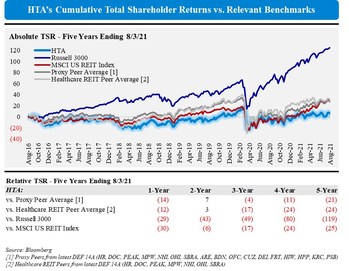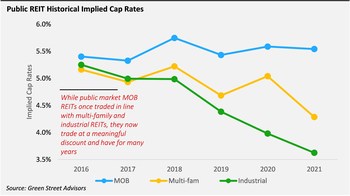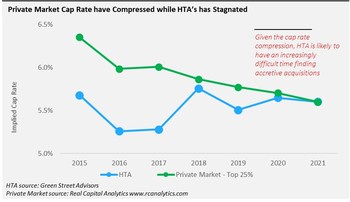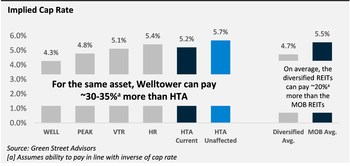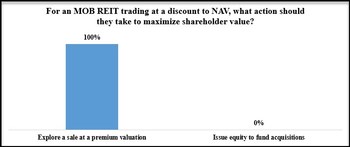Highlights Long-Term Underperformance and Frustrated Shareholders
Urges HTA to Conduct a Strategic Review
NEWS PROVIDED BY Elliott Investment Management L.P.
Oct 11, 2021, 12:29 ET
WEST PALM BEACH, Fla., Oct. 11, 2021 /PRNewswire/ — Elliott Investment Management L.P. and its affiliates (together “Elliott”), which is one of the largest investors in Healthcare Trust of America, Inc. (“HTA” or the “Company”), today sent a letter and an accompanying presentation to the HTA Board of Directors urging the Company to conduct a strategic review.
In the letter, Elliott highlighted HTA’s long-term underperformance and an untenable status quo, as the Company’s cost of capital makes it uncompetitive. Elliott also commissioned a third-party survey that shows that shareholders support its thesis that HTA should explore a sale at a premium valuation rather than pursue a stand-alone growth path.
According to the letter, Elliott stated they were confident that highly credible buyers will present compelling offers to acquire the Company at a substantial premium to the current trading price and prices observed prior to the recent resignation of HTA’s CEO and Chairman, Scott Peters. Elliott also added that since news of its involvement was first made public, it has received numerous private inbounds from other top shareholders voicing their support for a strategic review, including the active solicitation of bids for the Company.
Elliott concluded that it hopes to serve as a partner to HTA in this critical moment, and is eager to work with the Company to secure the best outcome for HTA’s shareholders.
The letter and presentation can be downloaded at RestoringtheTrust.com. The full text of the letter follows:
October 11, 2020
The Board of Directors
Healthcare Trust of America, Inc.
16435 N. Scottsdale Road, Suite 320
Scottsdale, AZ 85254
Attn: Chairman Bradley Blair II
Attn: Interim Chief Executive Officer Peter Foss
Dear Mr. Blair, Mr. Foss, and Members of the Board:
We write to you on behalf of Elliott Investment Management L.P. and affiliates (together “Elliott” or “we”). Elliott has a substantial investment in Healthcare Trust of America, Inc. (“HTA” or the “Company”), making us one of HTA’s largest investors.
First, we thank you for initially meeting with us last month and taking the time to hear our thoughts on the situation you face at HTA over the course of subsequent conversations. We appreciate that the resignation of Mr. Peters, the former Chief Executive Officer, was abrupt and unexpected. Second, we want to make clear that our goal is to work collaboratively with management and the Board of Directors to achieve a positive outcome for HTA’s shareholders, employees and medical tenants.
Introduction
We are making our views on HTA public today to emphasize the urgency of the situation and to ensure that the Board takes the necessary steps to maximize shareholder value. The Company is at a critical juncture following Mr. Peters’ departure, and the Board has not announced a formal strategic review process or (to the best of our knowledge) hired external advisors mandated to assist with such a review. HTA faces an increasingly difficult industry environment, which effectively precludes substantial growth on a value-creating basis. Many other industry participants such as diversified healthcare REITs, non-traded REITs (“NTRs”) and private owners with an ability to employ higher debt levels each have a meaningful cost-of-capital advantage over HTA. At the same time, those industry dynamics, when combined with highly favorable macroeconomic and financing conditions, make HTA’s assets particularly appealing to potential buyers.
HTA’s investors want the Company to explore a sale. This was true prior to Mr. Peters’ departure, and investors hold this belief with even greater conviction today. The decision to appoint a new chief executive officer is among the most important that a Board can make. Before the Board makes a decision regarding the right leadership for the Company going forward, investors believe HTA should run a strategic review, including the active solicitation of bids for the Company, in order to understand and assess all of its strategic options. This review must be transparent, thorough and carried out in good faith; if a “go-it-alone” strategy is perceived as being the Board’s predetermined choice, shareholders will not support that outcome, setting up the Company and any new potential CEO for conflict and failure. Moreover, unless the Board precedes its CEO search with an exhaustive strategic review process that satisfies shareholders, the Company will have difficulty attracting a talented and credible candidate.
We have conducted our own assessment, and we believe HTA will likely be best served by a sale to private equity, a non-traded REIT or a strategic buyer. Should HTA run a public sale process, we are confident that highly credible buyers will present compelling offers to acquire the Company at a substantial premium to both the current trading price and prices observed prior to Mr. Peters’ resignation (the announcement of which has driven M&A speculation and lifted HTA’s stock). In fact, since news of our involvement was first made public last week, we have received numerous private inbounds from other top shareholders voicing their support for a strategic review, including the active solicitation of bids for the Company.
A robust public marketing process, pursued with urgency, would allow the Board to take advantage of a favorable market environment and evaluate bids from the full universe of potential buyers. Regardless of whether an acquisition offer materializes, what is certain is that failing to run a comprehensive process to determine if such an offer exists would be unacceptable to HTA’s shareholders and constitute a failure by the Board to fulfill its duties. We expect that the Board will take the necessary steps to act in the best interests of HTA’s shareholders, and we look forward to working with you to achieve a successful outcome.
Our letter today is organized as follows:
Long-Term Underperformance: Despite assembling the largest pure-play collection of medical office building (“MOB”) assets, HTA has consistently underperformed its closest peers, broader REIT indices and the Russell 3000, frustrating shareholders.
The Status Quo is Untenable, as HTA’s Cost of Capital Makes It Uncompetitive: Since 2015, HTA’s cost-of-capital advantage relative to private market participants has disappeared. Worse still, diversified healthcare REITs today trade at nearly 100 bps tighter cap rates than HTA, enabling those REITs to pay ~20-25% more than HTA for the same MOB assets. These difficult industry dynamics are set to become even more challenging, as non-traded REITs, currently taking in approximately $1.5 billion1 in equity per month, enter the MOB market.
Investors Believe HTA Must Explore a Sale: In a third-party survey commissioned by Elliott, 100% of respondents indicated that an MOB REIT that is trading at a discount to NAV, as HTA has on a sustained basis, should explore a sale at a premium valuation rather than pursue a stand-alone growth path.
Credible Buyers Could Pay a Substantial Premium: We are confident that highly credible buyers are interested in acquiring HTA at a meaningful premium to the current trading price. To properly assess potential interest in HTA, the Company should hire advisors and conduct a robust strategic review, including the active solicitation of bids for the Company.
Elliott’s Investment in HTA
Elliott is an investment firm founded in 1977 that today manages approximately $48 billion of capital for both institutional and individual investors. We are a multi-strategy firm and a substantial investor in real estate, with significant investments in both private and public real estate assets. Since 2009, we have deployed more than $10 billion into real estate equity and debt in private real estate positions. Over the past five years, we have invested more than $2 billion in public real estate equities and REITs. Our firm has a dedicated real estate group that has built deep expertise in the real estate debt and equity capital markets and nurtured a network of relationships with major investors and relevant participants across the real estate industry.
Elliott’s investment approach, across all asset classes and sectors, is distinguished by our extensive due diligence, and our efforts to understand HTA’s situation have been conducted with the same thoroughness. We have enlisted industry experts, former employees and industry executives, investment bankers, lawyers, accountants and consultants as part of our work. We also commissioned an independent third-party survey of HTA’s investors. That survey reached investors holding, in aggregate, more than 50% of HTA’s shares. This exhaustive diligence effort, combined with our own conversations with industry participants, supports our conviction on the right course of action for HTA at this critical juncture.
Long-Term Underperformance
HTA has consistently underperformed its self-defined closest Healthcare REIT peers, broader REIT indices and the Russell 3000. Over almost any period over the last five years, HTA’s shareholders would have been better off buying the stock of any of HTA’s peers. Even more remarkably, HTA’s stock price is down over the five-year period that ended prior to the announcement of Mr. Peters’ resignation on the August 3 earnings call — after which investors began to very reasonably speculate that HTA would and should be a candidate for acquisition.
See Image 1: HTA’s Cumulative Total Shareholder Returns vs. Relevant Benchmarks.
Longstanding relative underperformance has led to understandable shareholder frustration and an increasingly impatient investor base, clamoring to see evidence of leadership’s willingness to explore all value-maximizing alternatives. This sentiment further highlights both the urgency of the situation and the opportunity before HTA leadership to reassure investors that they are aligned with shareholders in the pursuit of value-maximization.
The Status Quo is Untenable, as HTA’s Cost of Capital Makes It Uncompetitive
Staying the course will not work. The status quo is broken. While HTA has assembled a high-quality portfolio of MOB assets, it is clear that:
(i) The public market valuation of MOB assets has stagnated;
(ii) At the same time, private market cap rates for MOBs have compressed and are now in-line with public market cap rates;
(iii) Reflecting these points, HTA now trades at or below net asset value (NAV) and cannot consistently issue equity to make accretive acquisitions;
(iv) Growth will be further limited because HTA is at a cost-of-capital disadvantage relative to diversified healthcare REITs; and
(v) The competitive intensity is only likely to increase as non-traded REITs continue to grow and enter the market.
(i) The public market valuation of MOB assets has stagnated
MOBs possess many “core asset-like” qualities. MOBs generate consistent cash flow with 2-3% average NOI growth per annum and relatively limited volatility. The underlying tenant base is recession-resistant and higher quality than traditional office tenants. During the COVID-19 pandemic, MOB assets outperformed traditional office assets on key metrics. MOBs also house a greater percentage of credit-rated tenants than traditional office assets. Unlike traditional office tenants with generally similar needs, MOB tenants often require specialized buildouts or have strong location-specific preferences, driving 80%+ tenant retention.
MOBs will also benefit from powerful long-term tailwinds supporting the healthcare industry broadly and outpatient offices specifically. At ~18% today, healthcare spending is expected to grow to 20% of GDP in the next five to ten years.2 Technological improvements are enabling increasingly complex procedures to be performed outside expensive acute-care hospital settings and in lower-cost outpatient offices housed in MOBs, a shift embraced and encouraged by payers looking to rein in costs. At the same time, ever-increasing regulatory burdens and a drive toward integrated care have pushed historically self-employed physicians to become employed by large systems. This trend has resulted in increased credit tenancy and has benefited scale players like HTA, which has both the relationships and capacity to support large integrated health systems.
Over the past five years, public markets have rewarded “core asset” owners with tighter implied cap rates (higher valuations). But despite the favorable and “core-like” attributes outlined, implied cap rates on MOB assets have nonetheless stagnated. According to Green Street Advisors, since 2016, implied cap rates for industrial assets have fallen from ~5.3% to ~3.6%. Similarly, implied cap rates on multi-family assets have fallen from ~5.2% to ~4.3%. During that same period, public market MOB cap rates have actually increased from ~5.4% to ~5.5%. In short, whereas MOB assets once traded in-line with industrial and multi-family assets, which most investors deem “core,” MOB assets (when isolated in a public market context) for many years now have traded at a meaningful and widening discount for many years now.
See Image 2: Public REIT Historical Implied Cap Rates.
(ii) Private market cap rates for MOBs have compressed and are now in-line with public market cap rates
Amid the stagnation in MOB cap rates, increased investment flows from private buyers have eliminated the historical cost-of-capital advantage of publicly traded MOB REITs. Historically, HTA and its MOB REIT peers traded at tighter implied cap rates than individual assets would trade for in private markets. Since 2018, however, the gap between HTA’s implied cap rate and the cap rate on private transactions has compressed to parity.
See Image 3: Private Market Cap Rates have Compressed white HTA’s has Stagnated.
(iii) HTA now trades at or below its net asset value (NAV) and can no longer consistently issue equity to fund accretive acquisitions
In part because of limitations on their ability to retain earnings, REITs must generally issue equity to grow. When a REIT is trading above its net asset value (i.e., at an implied cap rate below private market cap rates), the market is ascribing some value to the REIT’s platform, and it makes logical sense for the REIT to issue equity to fund new acquisitions. Issuing equity at a lower implied cap rate than the cap rate on new acquisitions is, all else equal, accretive. By contrast, when a REIT is trading below its net asset value (i.e., at an implied cap rate above private market cap rates), the market is telling the REIT that it should not issue equity. Issuing equity at a higher implied cap rate than the cap rate on new acquisitions is, all else equal, value destructive.
From 2012 to the middle of 2017, HTA traded at an average 12.7% premium to NAV. From July of 2017 through the announcement of Peters’ resignation on August 3, 2021, HTA traded on average at a discount to NAV. Writing on the topic at the end of August, following a run-up in HTA’s price that brought HTA’s discount closer to parity, Green Street Advisors explained, “Given HTA’s neutral cost of capital (the Company and its MOB peers trade around NAV), external growth appears to be a value-neutral endeavor.”3 In short, because HTA trades at/or below NAV, the Company cannot reliably increase its value by issuing equity to fund new acquisitions.
(iv) Comparing HTA’s implied cap rates solely to private market MOB transactions actually understates the depth of HTA’s competitive challenge, as HTA also competes with diversified healthcare REITs for the same assets
Approximately 20-25% of assets in the portfolios of Welltower, Ventas and Healthpeak —the three largest publicly traded diversified healthcare REITs — are MOBs. These REITs trade at substantially tighter cap rates than HTA. On average, the three major diversified healthcare REITs trade at a 4.7% cap rate compared to HTA’s 5.7% unaffected cap rate.
See Image 4: Implied Cap Rate.
This is a meaningful difference. Analyzed on a “multiples basis” (simply inverting the cap rates) is perhaps more illustrative. HTA (unaffected) trades at ~17.6x the NOI its assets generate. The diversified healthcare REITs trade at ~21.3x the NOI their assets generate. This is a ~21% premium. Moreover, the diversified healthcare REITs all generally trade at a premium to NAV, which provides them with an investor mandate to issue equity to grow and an advantaged currency to fund acquisitions. When the diversified healthcare REITs grow, they will be forced to buy MOB assets if they wish to maintain their portfolio balance (i.e., without making the decision to increase exposure to MOBs). When a diversified healthcare REIT and HTA compete to buy an asset, HTA is at a fundamental disadvantage. Welltower, for example, can pay over 30% more than HTA for the same building and still have that transaction be accretive. As one research analyst pointed out, “While we would view heightened acquisition activity for the MOB dedicated names favorably, we note that increased attention on the asset class by the larger healthcare REITs (specifically WELL, VTR, PEAK), may result in downward pressure on initial cash yields.”4
(v) The competitive intensity is likely to increase as non-traded REITs continue to grow and enter the market
While historical non-traded REITs (“NTRs”) were viewed as over-levered, unsophisticated operators with high fees and disappointing returns, Blackstone (BREIT) and Starwood (SREIT) entered the private REIT industry in 2016 and 2017 and subsequently revolutionized it. Both investors offered an institutional reputation, operational expertise, a lower and more aligned fee structure, optimized leverage and improved reporting practices, leading to unprecedented growth. These two relatively new entrants have attracted ~$35 billion5 of inflows since inception and continue to draw robust investor demand.
Historically, the non-traded REITs built their businesses by buying industrial, multi-family and triple-net lease assets. In part because of the NTR capital that chased those assets, they are now often priced at entry yields that do not allow the NTRs to hit distribution hurdles. As a result, the NTRs are forced to broaden the property types they acquire. Given the “core-like” qualities of MOBs and based on our own conversations with industry participants, we are highly confident the NTRs are interested in acquiring MOBs at scale. In part because NTRs can employ higher leverage levels than public REITs (i.e. ~60% LTV vs. ~35% LTV for public REITs), the NTRs have a lower cost of capital than HTA. As a result, in the same way the diversified healthcare REITs can outbid HTA for an asset and still have the acquisition prove accretive, the NTRs can also outbid HTA while still earning a return above their (lower) blended cost of capital and their required distribution hurdles. As Capital One wrote, “HTA and other MOB REITs are facing a pivotal decision point in the sector’s direction with increased competition from private equity and the need to lower costs of capital to compete long term.”6
In addition to strong growth within existing vehicles, non-traded REITs are likely to become an even larger and more disruptive competitor in the market for assets as other “institutional quality” investors follow the path initiated by Blackstone and Starwood and launch their own vehicles. We believe MOB assets will be directly in the crosshairs of both existing and new NTR players.
Investors Believe HTA Must Explore a Sale
Investors and investment research analysts are acutely aware of these difficult industry dynamics. Raymond James recently summarized the situation well: “Stability has attracted robust demand for MOBs from private investors, so much so that cap rates have compressed to levels that make external growth activity challenging … MOB-focused REITs … are ‘stuck’ with prohibitive costs of capital that do not allow for a meaningful amount of accretive external growth activity.”7 In fact, not only have investment research analysts commented on the difficulty HTA will face in trying to grow, but also multiple research analysts have noted that HTA should explore a sale. It is highly unusual for research analysts to call for a public company to sell itself, yet in HTA’s case, following Mr. Peters’ departure, multiple analysts explicitly did exactly that:
“Given the current strong bid for medical office (MOB) assets as well as an unclear succession plan, we view a sale of the company as the best course of action [emphasis added]. We previously published our view that HTA would be an attractive M&A target given its high quality portfolio and valuation discount.” — Citigroup, August 4, 2021
“We want to say that this [Mr. Peters’ departure] could be a positive development that leads the interim CEO and board to explore a potential sale of the company, given compressing private market cap rates versus a lagging stock price in 2021. We certainly believe the board should look at strategic options [emphasis added].” — Capital One, August 3, 2021
Moreover, many analysts noted that the increased likelihood of a sale following Mr. Peters’ departure was a positive factor that would buoy the Company’s trading price:
“With investment activity increasing throughout the space, we will not discount the possibility of HTA being taken out or merged with another public company [emphasis added] insofar that valuation levels remain depressed versus peers and historical levels.” — Berenberg, August 5, 2021
“With the abrupt departure of HTA’s Chairman and CEO, we see increased uncertainty, but downside protection from M&A.” — BMO, August 3, 2021
“…High-quality MOBs have become a favored property type in recent years and management implied on the call that it would consider all avenues to maximize value [emphasis added]. This could represent a bit of a backstop for the stock.” — J.P. Morgan, August 3, 2021
“The abrupt and unexplained departure of the founder, Chairman, and CEO combined with numerous recent REIT M&A deals and record levels of private capital dry powder has led to increased speculation of a HTA takeout.” — Raymond James, August 20, 2021
“We think additional upside is relatively limited and the stock might trade off a bit, if a new CEO is named and HTA continues as a going concern.” — Truist Securities, September 30, 2021
The views of research analysts on a potential sale are widely shared by shareholders and the market. While it is possible to infer the privately held views of HTA’s investors based on the published research analyst material, in this case, it is not necessary. We commissioned an independent, third-party survey of HTA’s shareholders. In total, shareholders representing more than half of shares outstanding were surveyed. The results were unanimous:
See Image 5: Independent, Third-Party Survey Results.
Presented with the choice of (a) exploring a sale of a company like HTA trading at a discount to NAV at a premium valuation or (b) issuing equity to fund acquisitions, 100% of HTA’s surveyed investors chose option (a). Similarly, 100% of HTA’s shareholders supported a sale of the Company at a premium in line with premiums on recent REIT transactions.
Capturing the views of HTA’s shareholders, Citigroup real estate analyst Michael Bilerman might have put it best on HTA’s second quarter earnings call: “Why wouldn’t you take the opportunity today to at least explore, when the Company doesn’t have a CEO in place, to see if a combination with another public company or a complete sale to private capital may make more sense at this juncture versus continuing on a stay-the-course stand-alone public company basis.” For HTA’s investors, it is at once obvious and obligatory that the Board must conduct a robust strategic review of all of the Company’s options before it determines a path forward.
Credible Buyers Could Pay a Substantial Premium
HTA’s MOB assets would have significant value to potential acquirers. While employing higher leverage levels than publicly traded REITs, non-traded REITs aim to (i) hit similar high-single-digit to low-double-digit IRR targets and (ii) generate 5-6% cash-on-cash yields immediately following acquisition to meet required distribution thresholds. Using these parameters, and consistent with our conversations with industry participants, non-traded REITs could pay a substantial premium to HTA’s current stock price. A strategic buyer with a public currency could also pay a significant premium for HTA.
Even HTA’s own materials suggest the Company could be worth a sizeable premium to private buyers. HTA included a slide in its investor deck released on September 13, 2021 that states “high-quality, institutional” MOBs trade at cap rates in the “high 4’s, low 5” range, with portfolio sales pricing “25-100 bps lower” than individual transactions. That similar-quality assets trade at a substantial premium to the Company’s current (and unaffected) implied cap rates also underscores the difficulty HTA will have generating growth, as the Company does not have the currency to fund accretive acquisitions at these valuations.
Even if the Company were somehow able to (a) identify numerous high-quality assets trading below fair value and (b) outcompete other buyers for those assets (an improbable set of circumstances, for reasons outlined), we believe the upside and certainty of a sale still represents a more optimal risk-adjusted outcome for shareholders. As a simple exercise, even assuming HTA is able to meet the high-end of management’s inorganic growth target, it would take approximately four years for HTA to generate shareholder returns equivalent to the value shareholders would receive in a transaction today.8 This go-it-alone path involves considerable risk — including the implicit assumptions that HTA will be able to source attractively priced acquisitions in the future and fund them at reasonable costs — and, discounted at the Company’s cost of equity, still only yields a present value roughly equal to the current stock price. Faced with the decision of receiving a premium valuation today versus the uncertain path of trying to reach the same outcome years in the future with a go-it-alone strategy, we believe the choice is clear. Thus, to be clear, even if HTA were able to source and execute a handful of marginally accretive transactions in the near future, it would not meaningfully alter the overall analysis regarding the value-maximizing path for the Company.
Conclusion
The views outlined above reflect merely an abbreviated summary of our extensive diligence on the situation at HTA. We believe our expertise and extensive relationships as investors in the real estate market position us well to serve as partners to HTA at this critical moment. HTA faces a challenging stand-alone future given a disadvantaged ability to compete for acquisition targets, the inherently risky task of having to identify and integrate a new CEO and the difficult mission of repairing and rebuilding the Company’s culture. Given the lack of clarity on the Company’s strategic direction at this uncertain juncture, further delay in the public announcement of a strategic review (including the active solicitation of bids for the Company) will only lead to additional skepticism about the Board’s willingness to explore all value-maximizing alternatives, likely driving continued share-price underperformance.
Shareholders are in broad agreement about the best path forward, and that leadership must perform its duty. We are eager to work with the Company to secure the best outcome for HTA’s shareholders, and we look forward to doing so.
Best regards,
Dave Miller
Partner
Austin Camporin
Portfolio Manager
About Elliott
Elliott Investment Management L.P. manages approximately $48 billion of assets. Its flagship fund, Elliott Associates, L.P., was founded in 1977, making it one of the oldest funds under continuous management. The Elliott funds’ investors include pension plans, sovereign wealth funds, endowments, foundations, funds-of-funds, high net worth individuals and families, and employees of the firm.
1 Based on public filings of Blackstone Real Estate Income Trust, Inc. (“BREIT”) and Starwood Real Estate Income Trust, Inc. (“SREIT”)
2 Centers for Medicare & Medicaid Services, Office of the Actuary; U.S. Department of Commerce, Bureau of Economic Analysis
3 Green Street Advisors research dated 8/31/21
4 Berenberg Research dated 6/1/21
5 Based on public filings of BREIT and SREIT
6 Capital One research dated 10/5/21
7 Raymond James research dated 8/20/21
8 Based upon the top-end of HTA’s $375-600 million investment target, investment cap rates in excess of management’s 5.5-6.0% targeted range, NOI growth in line with the historical 2-3% range and the impacts of leverage and dividends
Media Contact:
Stephen Spruiell
Elliott Investment Management L.P.
(212) 478-2017
sspruiell@elliottmgmt.com
SOURCE Elliott Investment Management L.P.
The full content of this article is only available to paid subscribers. If you are an active subscriber, please log in. To subscribe, please click here: SUBSCRIBE






